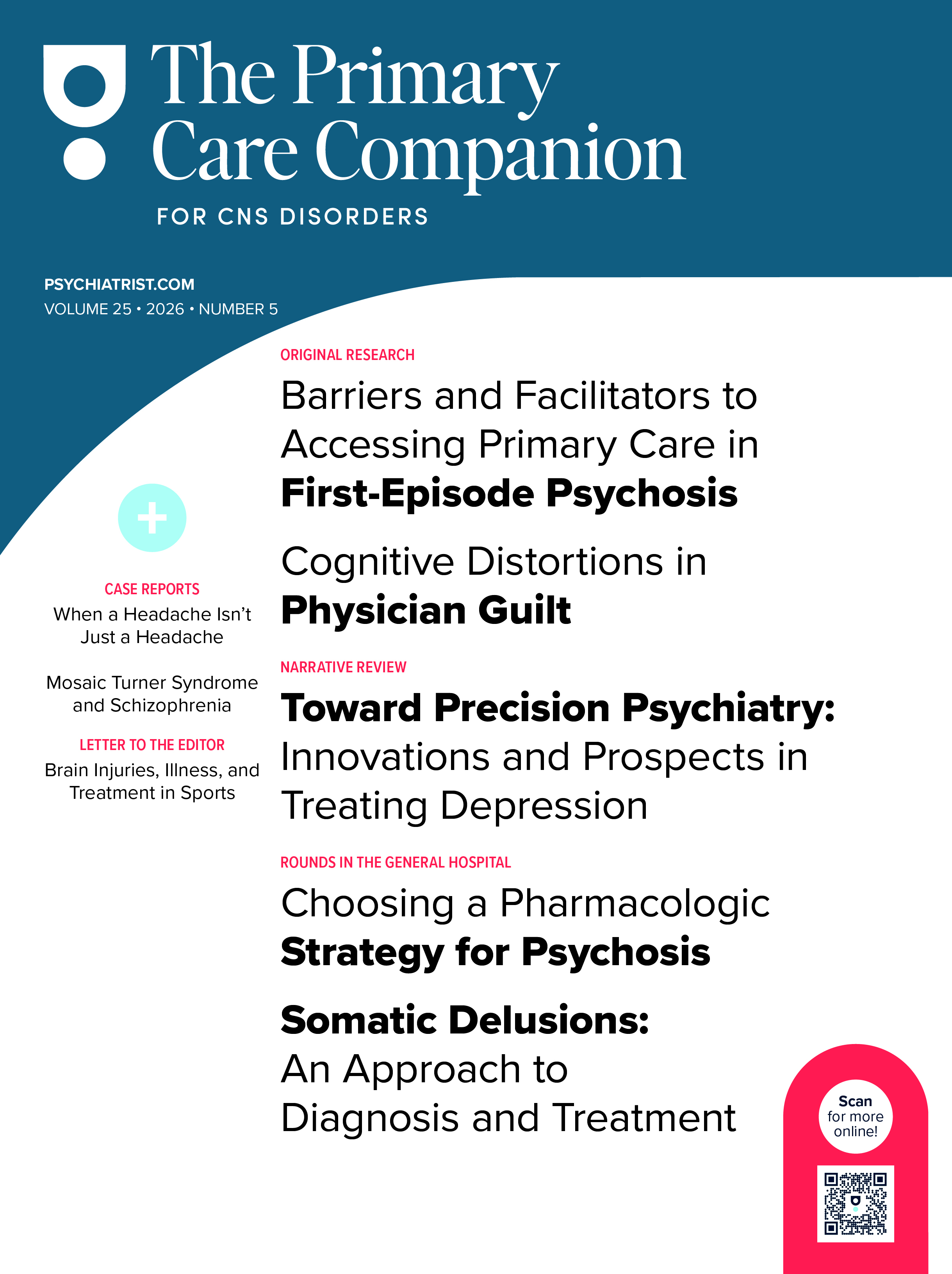Long-acting injectable antipsychotics (LAIs) are primarily used for schizophrenia and other psychotic disorders but may also be used off-label to manage other psychiatric conditions. Borderline personality disorder (BPD) involves instability in self-identity, emotional regulation, interpersonal relationships, and impulsivity.1 Autism spectrum disorder (ASD) involves challenges in social communication and interactions, behavior, and learning.2 Recent studies indicate increasing comorbidity between BPD and ASD, with overlapping symptoms complicating management.2
Psychotherapy, such as dialectical behavioral therapy (DBT), is the first-line treatment for BPD globally.3,4 While antipsychotics are often used off-label, their effectiveness for BPD remains unclear. Evidence shows that second-generation antipsychotics minimally modulate BPD symptom severity without significant functional improvement.5 Data on LAI use in BPD are limited; however, single studies suggest benefits in mood regulation and aggression reduction.6–9 Available literature shows LAI use in BPD patients for 3–6 months, with 1 study reviewing up to 24 months, but long-term stability data are limited.6–9
For ASD, behavioral therapies remain the primary approach, with antipsychotics like risperidone and aripiprazole having shown to be effective for the management of irritability and emotional dysregulation.10 Studies on long-term use of risperidone in children and adults are limited; some show symptom control up to 22 months, with improvements in hyperactivity, irritability, and anxiety, though LAI use is rarely discussed.11–13
Notably, there is a gap in understanding the effectiveness of LAIs for long-term stability in BPD or ASD, let alone for patients with both conditions. Herein, we present a case using risperidone LAI to demonstrate long-term stability in symptoms that overlap between BPD and ASD.
Case Report
A 55-year-old woman with BPD and ASD experienced 36 psychiatric emergency service visits over 13 years despite extensive psychiatric support and multiple medication trials.
Her symptoms include feelings of emptiness, abandonment fears, high emotional reactivity, irritability, and externalizing behaviors, while her ASD is reflected in difficulty sharing emotions and understanding relationships with stereotypies manifesting as rocking behaviors. Treatment has included DBT, intermittent psychotherapy, and trials of mood stabilizers, antidepressants, stimulants, anxiolytics, benzodiazepines, and oral antipsychotics, including risperidone, quetiapine, and ziprasidone, with a history of nonadherence.
The patient has utilized psychiatric emergency services for reasons including suicidal ideation, interpersonal conflicts, and mood dysregulation. During her most recent hospitalization for suicidal ideation, her medications were buspirone, clonazepam, oral risperidone, and trazodone. At discharge, she was transitioned to risperidone LAI 25 mg biweekly, with discontinuation of oral risperidone, clonazepam, and trazodone.
Since starting risperidone LAI, the patient has reported improvements in mood regulation, feelings of abandonment, interpersonal relationships, and a sense of identity, with reduced irritability and feelings of emptiness. The patient missed an injection once, and she experienced symptom recurrence; however, she was stabilized once her injections were resumed. Since starting risperidone LAI, the patient has not required psychiatric emergency services and has reengaged in psychosocial rehabilitation and psychotherapy.
Discussion
This case demonstrates that LAI risperidone may support emotional and interpersonal improvements in a patient with both BPD and ASD. The overlapping symptoms of BPD and ASD make it challenging to differentiate and target treatment. Both disorders have multifactorial etiologies, involving genetic and environmental factors, with dopamine and serotonin dysregulation potentially playing a role.14–16 Risperidone acts on dopamine and serotonin (5-HT2) receptors, which may explain the patient’s symptom improvement.17
Although a meta-analysis found limited efficacy for the use of antipsychotics in treating BPD,5 the reduction in psychiatric emergency service visits following the initiation of risperidone LAI in this case may indicate a benefit in symptom control for comorbid BPD and ASD, especially in nonadherent patients. Further research in controlled trials is warranted to explore this potential.
Article Information
Published Online: May 1, 2025. https://doi.org/10.4088/PCC.24cr03906
© 2025 Physicians Postgraduate Press, Inc.
Prim Care Companion CNS Disord 2025;27(2):24cr03906
Submitted: December 17, 2024; accepted January 22, 2025.
To Cite: Battle AE, Elmaoued AA. Reduction in emergency visits with risperidone long-acting injection in a patient with autism spectrum and borderline personality disorders. Prim Care Companion CNS Disord 2025;27(2): 24cr03906.
Authors Affiliations: University of New Mexico College of Pharmacy, Albuquerque, New Mexico (Battle, Elmaoued).
Corresponding Author: Amre A. Elmaoued, PharmD, University of New Mexico College of Pharmacy, 2600 Marble Ave, Albuquerque, NM 87106 ([email protected]).
Relevant Financial Relationships: None.
Funding/Support: None.
Patient Consent: Consent was received from the patient to publish the case report, and information has been de identified to protect anonymity.
References (17)

- Personality Disorders. In: Diagnostic and Statistical Manual of Mental Disorders. DSM Library. American Psychiatric Association Publishing; 2022.
- Dell’Osso L, Cremone IM, Nardi B, et al. Comorbidity and overlaps between autism spectrum and borderline personality disorder: state of the art. Brain Sci. 2023;13(6):862. PubMed CrossRef
- American Psychiatric Association. The American Psychiatric Association Practice Guideline for the Treatment of Patients With Borderline Personality Disorder. American Psychiatric Association Publishing; 2024.
- National Collaborating Centre for Mental Health (UK). Borderline Personality Disorder: Treatment and Management. British Psychological Society; 2009. Accessed August 25, 2024. http://www.ncbi.nlm.nih.gov/books/NBK55403/
- Gartlehner G, Crotty K, Kennedy S, et al. Pharmacological treatments for borderline personality disorder: a systematic review and meta-analysis. CNS Drugs. 2021;35(10):1053–1067. PubMed CrossRef
- Carrasco JL, Palomares N, Marsá MD. Effectiveness and tolerability of long-acting intramuscular risperidone as adjuvant treatment in refractory borderline personality disorder. Psychopharmacology. 2012;224(2):347–348. PubMed CrossRef
- Palomares N, Montes A, Díaz-Marsá M, et al. Effectiveness of long-acting paliperidone palmitate in borderline personality disorder. Int Clin Psychopharmacol. 2015;30(6):338–341. PubMed CrossRef
- Díaz-Marsá M, Galian M, Montes A, et al. Long-acting injectable risperidone in treatment resistant borderline personality disorder. a small series report. Actas Esp Psiquiatr. 2008;36(2):70–74. PubMed
- García-Carmona JA, Simal-Aguado J, Campos Navarro MP, et al. Off-label use of second-generation antipsychotics in borderline personality disorder: a comparative real-world study among oral and long acting injectables in Spain. Int Clin Psychopharmacol. 2021;36(4):201–207. PubMed CrossRef
- Salazar de Pablo G, Pastor Jordá C, Vaquerizo Serrano J, et al. Systematic review and meta analysis: efficacy of pharmacological interventions for irritability and emotional dysregulation in autism spectrum disorder and predictors of response. J Am Acad Child Adolesc Psychiatry. 2023;62(2):151–168. PubMed CrossRef
- TMcDougle CJ, Scahill L, Aman MG, et al. Risperidone for the core symptom domains of autism: results from the study by the autism network of the research units on pediatric psychopharmacology. Am J Psychiatry. 2005;162(6):1142–1148. PubMed CrossRef
- McCracken JT, McGough J, Shah B, et al. Risperidone in children with autism and serious behavioral problems. N Engl J Med. 2002;347(5):314–321. PubMed CrossRef
- Aman M, Rettiganti M, Nagaraja HN, et al. Tolerability, safety, and benefits of risperidone in children and adolescents with autism: 21-month follow-up after 8-week placebo-controlled trial. J Child Adolesc Psychopharmacol. 2015;25(6):482–493. PubMed CrossRef
- Hansenne M, Pitchot W, Ansseau M. Serotonin, personality and borderline personality disorder. Acta Neuropsychiatr. 2002;14(2):66–70. PubMed CrossRef
- Friedel RO. Dopamine dysfunction in borderline personality disorder: a hypothesis. Neuropsychopharmacology. 2004;29(6):1029–1039. PubMed CrossRef
- Nakamura K, Sekine Y, Ouchi Y, et al. Brain serotonin and dopamine transporter bindings in adults with high-functioning autism. Arch Gen Psychiatry. 2010;67(1):59–68. PubMed CrossRef
- McNeil SE, Gibbons JR, Cogburn M. Risperidone. In: StatPearls. StatPearls Publishing; 2024. Accessed September 1, 2024. http://www.ncbi.nlm.nih.gov/books/NBK459313/
Please sign in or purchase this PDF for $40.





